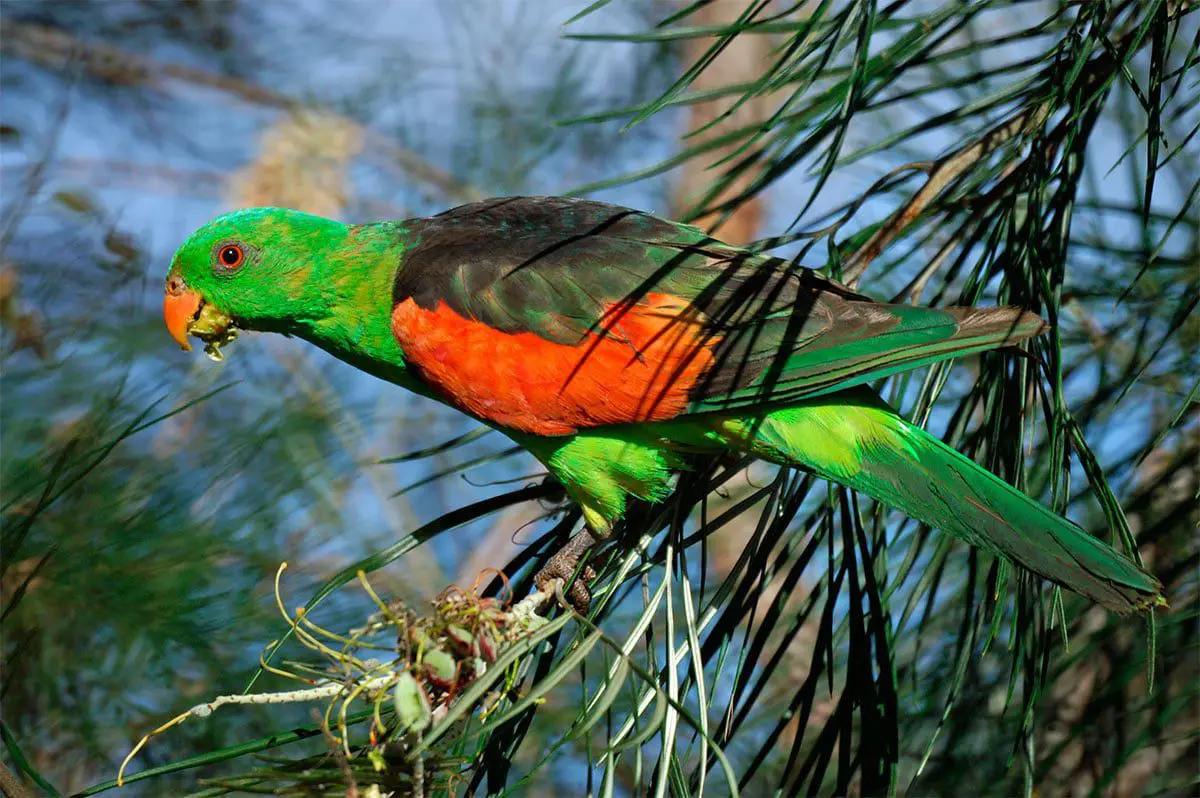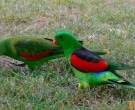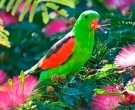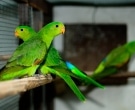Content
|
|---|
Description
30 to 33 cm.. length between 120 and 210 g. of weight.
The Red-winged Parrot (Aprosmictus erythropterus) has the head of color green bright with brightness blue green in the crown and nape. Mantle, back and scapulars black. Area low of it back and rump brilliant blue, more clear towards the tail; uppertail-coverts of color green yellowish with broadcasting yellowish at the base. Curve of the wing yellow-green light. Carpal edge blackish. Upper, the wing-coverts, bright Scarlet. Tertiary and primaries marked in black on vane inner, green in vane outer; secondaries also bathed in black in vane outer; primary coverts of color green dark bathed in black. Under, the wing-coverts green. The underparts bright, pale and slightly yellowish-green. Upper, the tail Green dark with tips of color yellow and lateral feathers Blackish in vane internal with yellow tips; undertail, the tail Blackish with tips pale.
Bill coral red; irises reddish brown; legs grey-black.
Female It is predominantly green with a small red spot in the wings (only a point apical on coverts major interiors, but the increase in the external; restricted to the outer feathers of the median) that of the male, and it ain't got no black on it the mantle; vane outside of outer secondaries black. The Green is also more off, and a bit more yellowish in them underparts. The rump is of a blue more off, and the glitter blue in it crown and nape of the male, is absent in the female. Under, the tail has tips yellowish and touches of color pink.
The immature they are similar to the females, but with a irises more Brown and bill yellow from the beginning. Young males attain adult plumage in the third annual moult, but black can show the mantle feathers before this.
- Sound of the Red-winged Parrot.
Description 3 subspecies
-
(Gould) 1865 – Male with more blue in it crown and nape. Both sexes slightly paler, and the female also more off the Green that it nominal species.
Aprosmictus erythropterus coccineopterus
-
(Gmelin) 1788 – The nominal.
Aprosmictus erythropterus erythropterus
-
(Mayr & Rand) 1936
Aprosmictus erythropterus papua
Habitat:
Resident, Although nomads in the edges of the range. Is semiarid and subtropical forests of eucalyptus and casuarina, boedes of the Woods, riparian forests, thickets of acacia, mangroves, agricultural fields, scrub Cypress pine (Callitris), and the lowlands of the Savannah.
On the inside of Australia are mainly linked to the extension of wooded of the systems fluvial.
They are usually found in small groups of up to fifteen birds, rarely reach more of 50 individuals in a single flock. The largest groups are likely to form late in the breeding season when family groups gather at feeding grounds..
The species is common and conspicuous, but not particularly accessible; When resent, birds can fly some distance, often making strong sounds.
Sometimes associated with the Pale-headed Rosella and Mallee Ringneck, and they feed under the trees, Although it is more usual to see them on Earth to drink.
Reproduction:
The nesting You can start early, in the months of April or may in the North, but august to february is the main breeding season in the south. During the courtship, the male perches near the female, exposing your blue rump, and making sounds.
The nest normally found in a eucalyptus, and the eggs are put into a deep hole covered with scrap wood. Three to six white eggs are They incubated for around 20 days by the female, which is fed by the male until the eggs hatch. The young are cared for by both parents and they leave the nest in a five weeks.
Food:
The diet It includes seeds, fruit, flowers and insects; in the mangroves, the mistletoe (Loranthus) is your favorite diet.
Distribution:
Size of the area of distribution (reproduction / resident): 5.230.000 km2
The Red-winged Parrot (Aprosmictus erythropterus) are confined in Australia, in the coastal districts of the southeast of Irian Jaya (Indonesian) and in the Western Province (Papua New Guinea).
In New Guinea, the species is restricted to the region between the rivers Digul and Fly.
In Australia extends from about Broome, in Western Australia (registered West of Anna Plains, and southwest of the Cordillera de Edgar) through the Kimberley region, including some islands on the coast (Buccaneer and Bonaparte archipelago, Islands Osborne and Sir Graham Moore, and Admiralty Gulf Islands) in the Northern Territory, about Nicholson.
Extends northward up to the peninsula of cobourg and to the South, at the turn of the Cordillera Camfield and Dunmarra Roadhouse, reaching some coastal islands, including Melville and Groote Eylandt.
Extends to the East in Queensland, in the nicholson river, are distributed in the Cape York Peninsula, with records by the coast, about Rockhampton (occasional southernmost), and reaching inside, about Dajarra, to the South of Mount Isa and Southeast, through the lower part of the diamond river, Windorah, Quilpie, Mitchell and San Jorge.
On the inside of New South Wales the end points of the range are in Inverell in the East, Gunnedah, Dubbo and Mudgee in the South and There is a, Menindee and Broken Hill, near the southern border of Australia.
They are also in the North, in the basin of the darling river, and have been recorded in the South-East of Australia, around the Lake Eyre and North of Cooper Creek.
Wandering individuals have been recorded in Renmark and Victory Downs, In this last, possibly from an exhaust.
Leaks have also been observed in Sydney and Melbourne.
The species is common in suitable habitats, except at their range limits.
The world's population is above the 100.000individuals and the species is considered secure.
A moderate number of captive.
Protected by law.
Distribution 3 subspecies:
-
(Gould) 1865 – South of New Guinea and Western Australia, to the East through the northern territory of the Cape York Peninsula, Queensland
Aprosmictus erythropterus coccineopterus
-
(Gmelin) 1788 – The nominal
Aprosmictus erythropterus erythropterus
-
(Mayr & Rand) 1936 – South of New Guinea
Aprosmictus erythropterus papua
Conservation:
• Current category of the Red List of the UICN: Least concern
• Population trend: Growing
The size of the world population It has not been quantified, Although it is estimated very above the 100.000 specimens.
The species, according to sources, is usually common and locally abundant (pit et to the. 1997).
The population is suspected that it may be in decline due to ongoing habitat destruction.
"Red-winged Parrot" in captivity:
Fairly common in Australia, not so much in other places.
Active, Acrobat; they require a large birdhouse with plenty of hangers. The male can become aggressive with the female.
Quite quiet and shy.
Una muestra vivió 24,4 years in captivity.
Alternative names:
– Red-winged Parrot, Red winged Parrot (ingles).
– Perruche érythroptère, Perruche erythroptère (French).
– Rotflügelsittich, Rotflügel-Sittich (German).
– Periquito-de-encontro-vermelho (Portuguese).
– Papagayo Alirrojo, Papagayo de Alas Rojas (español).
scientific classification:
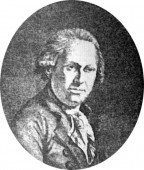
– Order: Psittaciformes
– Family: Psittaculidae
– Genus: Aprosmictus
– Scientific name: Aprosmictus erythropterus
– Citation: (Gmelin, JF, 1788)
– Protonimo: Psittacus erythropterus
Images “Red-winged Parrot”:
Videos "Red-winged Parrot"
————————————————————————————————
“Red-winged Parrot” (Aprosmictus erythropterus)
Sources:
– Avibase
– Parrots of the World – Forshaw Joseph M
– Parrots A Guide to the Parrots of the World – Tony Juniper & Mike Parr
– World Parrot Trust – parrots.org
– Birdlife
– Photos:
(1) – By David Cook Wildlife Photography from Wamboin, NSW, Australia [CC BY 2.0], via Wikimedia Commons
(2) – By Jan Harenburg (Own work) [CC BY 3.0], via Wikimedia Commons
(3) – Aprosmictus erythropterus erythropterus – Orde Psittaciformes – Papegaaiachtigen
(4) – Red-Winged Parrot (Aprosmictus erythropterus) Male – Pine Creek, M. 7. – encimages
(5) – “Aprosmictus erythropterus-Australia-pair-8” di Kitykat79 – originally posted to Flickr as King Parrots!. With license CC BY 2.0 Transact Wikimedia Commons.
(6) – A painting of two Red-winged Parrots (originally captioned “Platycercus erythropterus. Crimson-winged parraket. 1. Male. 2.Female.”) by Edward Lear 1812-1888. The painting shows a female behind young male by Edward Lear [Public domain], via Wikimedia Commons
– Sounds: Peter Woodall (Xeno-canto)
